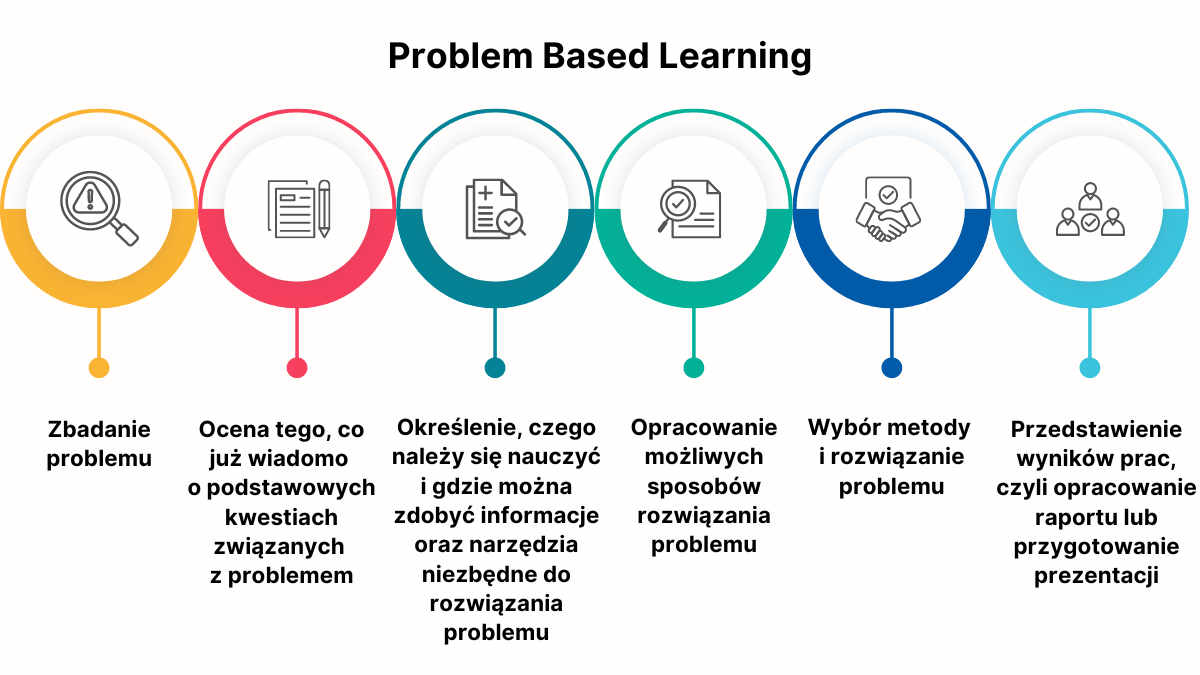Problem-Based Learning (PBL) is an educational approach where students are presented with realistic problems or situations, and then enabled to actively acquire knowledge and solve problems within the context of those situations. Students work in groups to solve real issues occurring in the socio-economic environment
The main features of the PBL method are:
- Problem tasks as the starting point - Teachers present students with specific problems or situations they might encounter in the real world. These tasks serve as the starting point for the learning process.
- Active student role - Students play an active role in their learning. Instead of passively receiving information, they independently acquire knowledge by researching, analyzing, and synthesizing information to solve problems.
- Interdisciplinarity - The PBL method often engages various fields and disciplines, allowing students to understand the problem from different perspectives. This promotes interdisciplinarity and the development of critical thinking skills.
- Group work - Students work in small groups to exchange ideas, share knowledge, and collaboratively work towards solving the problem. This group interaction helps develop soft skills such as communication, group work management, and the ability to discuss and argue.
- Teacher support - The teacher acts as a guide, mentoring students in the problem-solving process. Instead of traditionally transmitting knowledge, the teacher directs the learning process.
- Assessment of both the process and the final outcome - Assessment in PBL includes both the process and the outcome of the students' work. It evaluates the ability to solve the problem as well as the ability to collaborate in a group, creativity, critical thinking, presentation skills, etc.
The PBL method aims to develop practical skills, creative thinking, collaboration, and problem-solving. It also serves as a motivational tool, as students often engage more in learning when they see the connection between what they are doing and the real world.
Implementing PBL during classes involves presenting students with problems they will need to solve. These should be realistic situations that resemble those students may encounter in their future professional work or life. Before starting, it is necessary to establish basic principles for student work and the method of assessing the task. Peer assessment can be used, but it should not be the sole evaluation of the task, only a component of the final assessment.
Part of the theoretical knowledge necessary to solve the problem should be provided during theoretical classes, and the rest, depending on the specifics of the problem, must be supplemented by the students themselves.

Advantages of PBL:
- Development of practical skills: PBL focuses on solving real-world problems, which helps students develop practical skills necessary in their future professions. They acquire skills in analysis, problem-solving, communication, and collaboration.
- Strengthening interpersonal skills: By working in groups, students develop collaboration, communication, negotiation, and conflict resolution skills. These skills are key in the workplace and society.
- Motivation to learn: PBL can increase students' motivation to learn because the problem they are trying to solve is directly related to reality. This makes the learning process more engaging and meaningful for students.
- Developing critical thinking: The process of analyzing a problem, gathering information, and developing a solution in PBL develops critical thinking skills. Students learn to evaluate information, make decisions, and argue their positions.
- Ability to think interdisciplinarily: PBL often involves different fields in problem-solving, allowing students to view issues from various perspectives. This develops the ability to think interdisciplinarily.
- Independent learning: Through PBL, students learn to be independent in acquiring knowledge. They become more responsible for their learning process, which prepares them for independent action outside the academic environment.
- Preparation for real work situations: PBL prepares students to deal with dynamic and changing professional environments. Students learn about problem situations that occur in practice and apply the theoretical content of classes to real-world examples.
- Multifaceted assessment: This method allows for the assessment of not only the final outcomes but also the learning process. Teachers evaluate both the individual engagement of students and their ability to collaborate in a group, as well as the process of approaching problem-solving.
For more information, please visit:
Cornell University, Problem Based Learning, https://teaching.cornell.edu/teaching-resources/engaging-students/problem-based-learning
Nilson, L. B. (2010). Teaching at its best: A research-based resource for college instructors (2nd ed.). San Francisco, CA: Jossey-Bass.